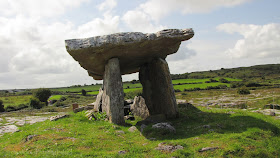This ancient portal tomb, built by Neolithic farmers more than 5,000 years ago, is not only the second largest in Ireland, it’s also one of the best preserved of its kind in the country.
Poulnabrone is a classic
example of a Neolithic portal tomb, consisting of two tall portal stones leading
into a stone-lined chamber. The tomb is covered by a 30 cm thick capstone, forming a roof that slopes towards the west. The dolmen stands on an elevated point along the main road between Ballyvaughan and Corofin in the Burren region of County Clare. The area is dominated by the typical Burren karst landscape with its exposed cracked pavement of limestone rock.
The name Poulnabrone stems from the Irish Poll na Brón, meaning "hollow of the millstone".
During the Neolithic or New Stone Age, farming and agriculture became wide-spread and people throughout Europe started to settle and build large stone tombs to honour their ancestors. About 170 stone tombs can be found on the island of Ireland - over 90 of them in the Burren region alone.
Excavations in 1986 and 1988 revealed the remains of 33 adults and children buried here who lived between 3800 and 3200 BC. Buried with them were personal belongings like a polished stone axe, flint weapons, pieces of pottery, stone beads, quarz crystals and bone pendants, Almost all the adults died under the age of 30 and their bones showed signs of arthrits and malnutrition, indicating a life of hard physical labour.
Buried just outside the entrance the remains of a newborn baby were found. Radiocarbon dating revealed that the infant was buried here during the Bronze Age, more than a thousand years later than the others inside the tomb. This suggests that the portal tomb was still an important place for the rituals of later generations more than a millenia after it was erected.
German version:
Diese Grabstätte wurde von neolithischen Bauern vor mehr als 5000 Jahren errichtet. Sie ist nicht nur die zweitgrößte in Irland, sondern auch die am besten erhaltene im Land.
Poulnabrone ist ein klassisches Beispiel eines jungsteinzeitlichen Portalgrabes mit zwei großen Portalsteinen, die den Eingang in die steinerne Grabkammer bilden. Das Dach der Grabkammer besteht aus einer 30 cm dicken Steinplatte, die sich in Richtung Westen hin abneigt. Der Dolmen steht auf einer natürlichen Anhöhe entlang der Hauptstraße zwischen Ballyvaughan und Corofin in der Burren Region der Grafschaft Clare. Die Burren Region ist bekannt für die Karstlandschaft mit den typischen freigelegten Kalksteinplatten.
Der Name Poulnabrone kommt aus dem Irischen Poll na Brón und bedeutet "Aushöhlung des Mühlsteins". In der Jungsteinzeit verbreitete sich der Ackerbau und die Menschen in ganz Europa begannen sesshaft zu werden und große Steingräber zu errichten um ihren Vorfahren zu gedenken. An die 170 dieser Steingräber finden sich in Irland, allein 90 davon in der Burren Region.
Bei Ausgrabungen in den Jahren 1986 und 1988 wurden die Überreste von 33 Erwachsenen und Kindern entdeckt, die zwischen 3800 und 3200 vor Chr. hier gelebt haben. Persönliche Grabbeigaben wie eine polierte Steinaxt, Waffen aus Flintstein, Tonscherben, Steinperlen, sowie Schmuck aus Quarz und Knochen wurden ebenso gefunden. Die meisten der Erwachsenen wurden nicht älter als 30 Jahre alt und zeigten Anzeichen von Arthritis und Unterernährung, was auf ein Leben schwerer körperlicher Arbeit hinweist.
Vor dem Portal zur Grabkammer wurden die Überreste eines Neugeborenen gefunden. Die Radiokarbondatierung ergab dass der Säugling erst in der Bronzezeit hier beerdigt wurde, mehr als tausend Jahre nach den anderen Beerdigten im Inneren der Grabstätte. Das weist darauf hin, dass diese Grabstätte auch für spätere Generationen noch ein wichtiger Ort für Rituale war, mehr als ein Jahrtausend nachdem sie errichtet wurde.














This blog is really good. I appreciate your hard work in writing this blog. It helped me lot to increase my knowledge.
ReplyDeletedwell village melbourne city